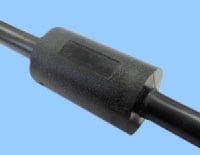Radio Frequencies “Freqing” Out Equipment? Eliminate Unwanted EMI.
Posted on 9/25/24 9:14 AM
Whether caused by an ill-conceived electrical design or other nearby frequencies, electromagnetic havoc can interfere with or cause damage to sensitive equipment. While electromagnetic interference (EMI) and radio frequency interference (RFI) are often used interchangeably, EMI is typically the more comprehensive term. A basic example of EMI is the effect of lightning and its electrical discharge causing static across multiple frequencies. While atmospheric discharges are nearly impossible—if at all—to suppress, there are many methods to suppress EMI in machines that use AC power.

Ferrites
Magnetized ferrite beads, commonly made of nickel-zinc (NiZn) or manganese-zinc (MnZn), suppress low, medium, and high-frequency noise. Ferrites are molded or snapped over the cable in a cylindrical shape, the beads inside the PVC mold positioned nearest the conductors for maximum suppression of EMI. Designed for suppression of frequencies between 25 and 300MHz, ferrites offer medium permeability (penetrability) and resistive impedance. A combination of oxides from other metals, such as magnesium, manganese, copper, or cobalt, may also be found in a ferrite.
Ferrite beads are not resistors, capacitors, or inductors; however, they share similar characteristics depending on the electric fields they encounter in particular arrangements. While Interpower ferrites are molded onto North American cable, there is also an option for international cable.
“Ferrites were invented in North America, and designed with American Wire Gauge (AWG) outer diameters in mind,” said Interpower’s Technical Support Specialist, Dan Ford. “We have tried to locate ferrites for molding on different international cables, but they will not properly mold onto the cord as resin will creep between the ferrite and the cable jacket, fracturing them. Therefore, we offer snap-on ferrites on international cable types.” The difference is the minute size difference between AWG and international cable.
When determining what kind of ferrite to use on a cable, there are several factors to consider: impedance range, frequency range, and size and type of cable it will be used on. When applying the ferrite onto the cable, Interpower recommends molding it four to six inches from the strain relief on the equipment end, or on the IEC 60320 connector of a cord set.
Modules & Shielding
While ferrites are a reliable and trusted solution, there are other EMI suppression tools that may squelch radio interference problems. Shielded cable or shielded tape help eliminate noise. If working in the medical field, you may want to include a power module that comes with an EMI filter housed inside an RF metal shield. Also, RF shielding boxes are an option to reduce noise.
Finally, European exports must meet noise directives established by CISPR, an International Special Committee on Radio Interference, which is part of the IEC. You will need to be current with the IEC standards that apply to your product category.





